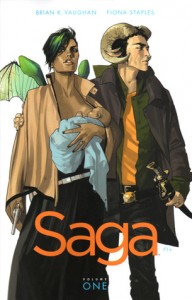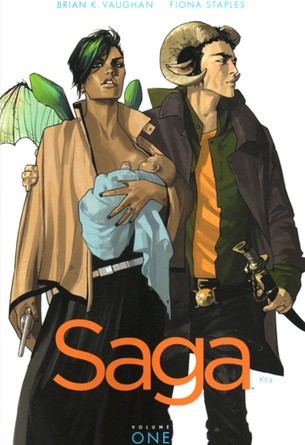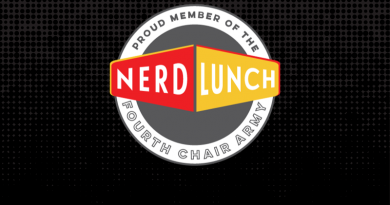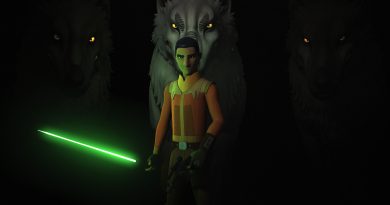FANgirl’s SAGA Read-Along: Beginnings
It’s time to kick off FANgirl’s first Put More Of This In My Star Wars Read-Along, featuring the graphic novel Saga by Brian K. Vaughan and Fiona Staples. I explained the premise of this new adventure for our blog in a post earlier this month:
Each of the stories picked will have some connection to Star Wars and will promote our goals as readers and fans. We’re going to show you what we like to see in our stories, and we invite you to join us on the adventure.
Our winner of the Read Along giveaway copy was Amanda Bond. Thanks for participating!
Linda kicked off the conversation on Twitter after opening the book and being sucked in.
[tweet_embed id=554844630605254656]Kay also offered feedback that the story grabbed her.  Mary’s reaction has been more mixed, although one character inspired her enough to contribute an amazing character dissection that will help spur the discussion next week.
Mary’s reaction has been more mixed, although one character inspired her enough to contribute an amazing character dissection that will help spur the discussion next week.
To start, let’s talk about the opening chapter:
1) One of the great elements of the Star Wars movies is the use of in media res. The characters and situation are fleshed out but the audience has to dive in. That’s also true in the first chapter of Saga. What did you think?
2) The opening jumps into the birth of the narrator, Hazel. Would you define this as graphic, or just a representation of life?
3) Following up on the previous question, we see boobs, blood, and obscenities. Do you think the story is challenging a double-standard about the female body and sexuality versus violence and gore in storytelling?
Feel free to leave your comments here and then share them on social media. Let’s keep the conversation going!
For updates on all things FANgirl follow @FANgirlcantina on Twitter or like FANgirl Zone on Facebook. At times she tries the Tumblr.
- Hyperspace Theories: Bad Luck Ghorman - June 2, 2025
- Hyperspace Theories: One Year Later as ANDOR Kicks Off Season Two - May 15, 2025
- REVIEW: Tales of the Underworld - May 4, 2025











FWIW, here are my thoughts on Saga, Chapter One. ****SPOILER ALERT****
Opening a book to find characters already involved in some kind of action is much more interesting to me than a tale written beginning to end, in chronological order. Saga’s first chapter is one in which you learn a great deal about the main characters and their situation very quickly: …she’s giving birth…it’s her first baby…mother and father are different species…mother seems stronger-willed than father…they’re hiding out… etc. I liked the rather breathless way readers could hit the ground running in this story, gaining a lot of information about past, present, and future in just a few pages.
It might have been a risky choice to begin with a vivid birth scene. There is a fine line to tread when it comes to realism and material than has the potential to make readers who might be sensitive to it somewhat uneasy, and it’s not something we expect to see at the beginning of a comic or graphic novel. This was a bold move that makes a statement against established standards which is why I liked it. I also think that these pages were written and illustrated well without being offensive or overtly graphic (although as an ex-RN, it would take a very extreme birth scene to offend me). I would be surprised to find very many people were upset by it.
Hazel’s birth is life – in this case, the narrator literally came to life as readers began to identify the characters. It was a different way to “meet” the narrator, and made for an interesting way for readers to “listen” and watch her retell her own story. We meet baby Hazel and grown-up Hazel at the same time, which was something I enjoyed.
I think that Saga (at least Volume 1) aspires to challenge the classic representation of the female body in comics by immediately presenting its reproductive function rather than the pre-productive sexuality aspect. Throughout the rest of the book, breasts are displayed prominently but to nurture the baby and perhaps as an illustration of their importance beyond the gratuitous, overblown, hyper-sexualized boobs we are used to seeing. I am a little uncertain as to whether that differentiation was successfully achieved. In the time since I read the book, I remember seeing probably more free-ranging boob than was necessary to make the point, and the fact remains that breasts are readily exposed while male parts are not, even when in use.
The blood and obscenities in chapter one were appropriate to the scenes, I thought. Again, the context of birth is different from violence and gore yet the process of birth is also bloody, dirty, and very often accompanied by shocking obscenities plus occasional, relatively minor acts of violence. Still, this chapter managed to follow up the realities of birth with actual violence and a certain amount of gore, and in that way, rather effectively played the similarities and differences against one another. There was a sequence to the action: pain/blood-fear-joy (Hazel’s birth), a few moments of peace, and then fear-pain/blood-joy (firefight/escape). This was an interesting balance that provided comparison and distinction.
Starting in medias res is usually a risky endevour, both for the writer and the reader; the writer has to have a pretty solid world (and story) down and the reader has to take a leap of faith. Having some assists from the writer helps ease the reader in. In Saga’s case, the characters are clearly aliens, but the dialogue is pretty human, we get the emotion right away, which is part of why it’s easy to get swept in. There are all sorts of hints that maybe the new parents aren’t all that familiar with each other (the “please don’t be into that” line stands out) and though the setting is grim, we know that the new baby makes it, as she’s telling the story–it makes the tone overall more optimistic and allows the the levity to fit in.
Having witnessed a number of actual births (though all human, granted) I can’t say it was particularly graphic– maybe pretty annotated, compared to a first time human birth might actually be. The nudity there didn’t bother me so much, as the gratuitous nudity in later scenes with The Will. Okay, he’s jaded about alien sex– I didn’t need to see all those variations for the point being made. Still, Vaughan has said the comic was “Star Wars for perverts” so I suppose it is not too surprising. I think while in those scenes the graphic portrayal of body parts was roughly equal, there was a lot more female nudity overall. Again, it didn’t bother me personally, but having a kid, it isn’t the kind of book I feel comfortable to have lying around.
Saga, volumes 1-4
I have conflicting feelings on Saga. I was immediately drawn to its beautiful art and I quickly came to love the characters. But other parts turn me off.
I recall reading the author commenting on how he wanted to make this comic too mature to be able to be turned into a tv series, and if true, it comes across in how disconnected the sex and gore feels to the rest of the story. I don’t mind sex in my stories; it felt naturally part of the story of ElfQuest, I read and write smut fanfics. But here, the sex feels gratuitous to me. The gore feels excessive. It doesn’t feel needed for the story but only there to make the comic “edgy”. Minor Spoiler for later story: Add in one of the characters using drugs and I start feeling majorly turned off.
And so I can’t entirely like this series. There are interesting characters, a neatly developed world, a compelling storyline, but there and there are parts that leave me cold.
Linda, I very much agree with you. I had not considered the issue of optimism in light of the reader knowing that Hazel “makes it”. Good point.
Li, I have only read Volume 1 (at least so far), but like you, I feel very conflicted about Saga. The art is very pleasing, but for me, I began tuning out because of some of the characters.
Your statement about the use of excessive gore to “make the comic ‘edgy'” is another point well taken. I definitely agree with you there as well.
I loved the in media res. I like the idea that a world/these characters existed before you as the reader got here and that they’ll all still be there going about their lives after you leave. This was a well-executed opening with natural information-giving and I think it’s a big part of why I felt immediately sucked in. And I agree with Mary it was good pacing too.
I didn’t mind the birth scene graphic-ness because it was part of something that added to the story. I willing to chalk the obscenities up to characterizations but most of the other graphic parts and nudity did not seem necessary at all. The Will seemed like they just wanted to see how many boobs they could get on the page. Yet Izabel’s graphic qualities didn’t bother me because it was part of how she died, being all one color tones it down slightly, and it isn’t featured in every frame she’s in.
And by The Will, I meant The Stalk.
So since we’re talking about the first chapter I’ll just echo what’s already been said. Like Mary I enjoy being thrown in the middle of action. Sometimes when we spend a lot of time setting things up you lose the space to engage and develop charachters. So in this case we see two new charachters in a very stressful situation and can guage thier reactions and build our opinons based on this moment where no one is ever really at thier best.
In terms of how graphic this first section was — I didn’t have a problem with the birth scenes, but I did as Linda mentioned earlier, have an issue with the stuff with The Will later on in the book. Mostly b/c I wasn’t quite sure what the intention was. I believe that showing hypersexual situations and violence needs to have a point otherwise it doesn’t really do much for building the “Saga” part of the story.
Things I did like about the first section (or maybe this was how I felt at the end of the story)? It sent up differences between the Planet and Moon societies and acknowledged the importance of not judging everyone by first impressions. When writing a diverse group of charachters it’s an important thing to set up early.
I thought the use of in media res was very effective. Even in just 22 pages we meet the main characters and the immediate dangers they’re up against, as well as learning the basics of the broader context of the galactic war. Although the visual look is distinctive, many of the elements are familiar: laser weapons and magic, soldiers and bounty hunters, heroes on the run from powerful governments with sinister agendas, and much more. So while the story had a lot of world-building to unfold, I found it really accessible.
The opening is a nice twist on the way too many stories use gore or graphic imagery for shock value. To me, the dialogue was much more graphic than the visuals. It also really set the tone of the two characters, and their relationship with each other. Even some of the more gory aspects, like Marko biting the umbilical cord, served the story purpose of showing just how committed he is to not using the sword.
I do think the story is deliberately using equal-opportunity “mature content” to make a point about sex and violence. Both can be grotesque – and we shouldn’t flinch at seeing them that way. While the scenes on Sextillion were quite graphic, I found it effective for two reasons. One, it’s basically The Capitol from The Hunger Games dialed up to 11 – showing how truly abominable and corrupt powerful parts of the galaxy can become. (The earlier sex scene with the Robot aliens established that dynamic, as well.) Two, the extreme debauchery leads into the revelation of the young girl The Will encounters and tries to rescue. Her plight is so atrocious that it sparks a seemingly cold and heartless man like The Will to want to save her. (Including a comparably graphic violent moment when he smashes the pimp’s head to bits with his bare hands.) The prior scenes work well to set that up, for me.
I can see why, though, for some readers the graphic violence and sexual content would get in the way of reading Saga as fun or escapist fiction. Saga is clearly a space fantasy epic, but it doesn’t have the light-heartedness and fun of a story like Star Wars. (Some of the humor is pretty funny, although much of it’s dark humor.) For me, the takeaway might be that I’d have to be in the right mood to read Saga. I found it to be a captivating story, and I definitely wanted to keep reading – but I can see how it’s not for everyone.
So the post office finally delivered my copy and I sat down and read it all in one night. I’ll try to keep my musings to Chapter One only,
I am just going to share my impressions, in no particular order.
****SPOILERS AHEAD****
Is Fiona Staples art just the best for the story? It’s beautiful, yet in places it looks raw and the edges look rough. I like how none of the people are idealized, with over voluptuous perfect bodies (Although seriously Alana looks great for being so preggers). I really appreciate the variety of aliens, with different looks that seem to reflect a whole galaxy of possibilities of life forms, even while there is something human about most of them (or cat, and really I have suspected cats were an intelligent race from the stars for some time now).
The tone of Star Wars is far more innocent and child-like than the gritty tone of Saga, even while both of them are Space Fantasies. I didn’t find the birth, or the boob, or the gunfight to be all that disturbing but the robo sex scene made me blink. I get that we were trying to show how the war had affected IV and given him PSTD but I didn’t need to know their favorite position. I really didn’t. Saga does not feel light-hearted – it feels almost world weary, as people are neither good nor bad but just dealing with the world at hand. Star Wars feels more like a battle of good and evil, while Saga feels more like people just trying to survive. Where Saga and Star Wars tone cross are in their treatment of war and the effects of politics. Both Saga and Clone Wars show the effect of war on people, on innocent people caught up in greater conflicts. So far Saga has not introduced a villain like Palpatine, but instead seems to show people like IV with PSTD and who is so blinded by nationalism that he can’t see the irony of complaining about having to delay starting a family while he goes off to hunt down and kill another. The Will could potentially be a villain, but his sorrow at killing a magnificent creature indicate he is not the simple killer people think he might be.
Alana and Marko have a Han and Leia like passion – as easily turned to fighting as to loving one another, they can go from fighting to flirting in the blink of an eye. That kiss at the end of Chapter One – amazing.
I think comparing Marko with The Will and their moralities will be really fascinating. We see Marko a conscientious objector making a vow not to fight, but he’s ready to pull that sword in defense of his family and having no regrets. We see The Will kill a creature and mourn his actions. Could this be an Anakin sort of morality tale, where the right reasons can lead us down a terrible path?
I would be interested in a discussion on comparing the morality of Star Wars and Saga, because while I get more of a sense of good vs. evil from Star Wars, I think Clone Wars especially had a lot in common with Saga about showing how good people can do bad things and how bad things can be done for good reason and sometimes it is all a big mess to try to figure it out.
Some really good points there. I hadn’t even thought much about how there is no one big villain. The war is the villain in a way. It’s putting characters in life or death situations they’d probably not find themselves in otherwise.
Marko and Alana do have a kind of passionate, argumentative Han and Leia-ness to them, don’t they? Also two people who probably wouldn’t have found their way to each other without the war.
Mary: Hazel’s birth is life – in this case, the narrator literally came to life as readers began to identify the characters. It was a different way to “meet” the narrator, and made for an interesting way for readers to “listen” and watch her retell her own story. We meet baby Hazel and grown-up Hazel at the same time, which was something I enjoyed.
I hadn’t thought of it that way until I read your comments. The birth scene overall set the tone of female characters not being in the story for their sexualization but for the many other reasons women exist. Not to say we don’t see sexualization later, but it serves narrative purpose.
Linda: In Saga’s case, the characters are clearly aliens, but the dialogue is pretty human, we get the emotion right away, which is part of why it’s easy to get swept in. There are all sorts of hints that maybe the new parents aren’t all that familiar with each other (the “please don’t be into that” line stands out) and though the setting is grim, we know that the new baby makes it, as she’s telling the story–it makes the tone overall more optimistic and allows the the levity to fit in.
Sometimes stories come across as the author is learning the characters as they write them. I felt like here the storytellers knew the characters from the start. Relating to my own work in WYNDE, I went back to the first ten chapters near the end of my writing the novel and rewrote most of that part because I felt like I knew Vespa better at that point.
Li: And so I can’t entirely like this series. There are interesting characters, a neatly developed world, a compelling storyline, but there and there are parts that leave me cold.
This is definitely not a story for everyone.
Kay: I loved the in media res. I like the idea that a world/these characters existed before you as the reader got here and that they’ll all still be there going about their lives after you leave. This was a well-executed opening with natural information-giving and I think it’s a big part of why I felt immediately sucked in. And I agree with Mary it was good pacing too.
The beginning sucked me in too and I had read half the book when the intent had been to skim the first few pages!
Priya: Things I did like about the first section (or maybe this was how I felt at the end of the story)? It sent up differences between the Planet and Moon societies and acknowledged the importance of not judging everyone by first impressions. When writing a diverse group of charachters it’s an important thing to set up early.
The worldbuilding beyond the characters was already getting trickled out too. This is one of the reasons Star Wars movies work as well. You can see the conflict from the opening shots with just two ships. Here it’s just two people in a room having a baby but the conflict appears quickly.
BJ: While the scenes on Sextillion were quite graphic, I found it effective for two reasons. One, it’s basically The Capitol from The Hunger Games dialed up to 11 – showing how truly abominable and corrupt powerful parts of the galaxy can become. (The earlier sex scene with the Robot aliens established that dynamic, as well.) Two, the extreme debauchery leads into the revelation of the young girl The Will encounters and tries to rescue. Her plight is so atrocious that it sparks a seemingly cold and heartless man like The Will to want to save her. (Including a comparably graphic violent moment when he smashes the pimp’s head to bits with his bare hands.) The prior scenes work well to set that up, for me.
Well said.
Amanda: Is Fiona Staples art just the best for the story? It’s beautiful, yet in places it looks raw and the edges look rough. I like how none of the people are idealized, with over voluptuous perfect bodies (Although seriously Alana looks great for being so preggers). I really appreciate the variety of aliens, with different looks that seem to reflect a whole galaxy of possibilities of life forms, even while there is something human about most of them (or cat, and really I have suspected cats were an intelligent race from the stars for some time now).
The cat thing works! He is one of my favorite characters and says very little. As my friend says, “we’re all subkitty creatures.” Staples art is unique and stunning. She is imagining this whole new universe.
Pingback:SAGA Read Along: Inspiring Characters « FANgirl Blog